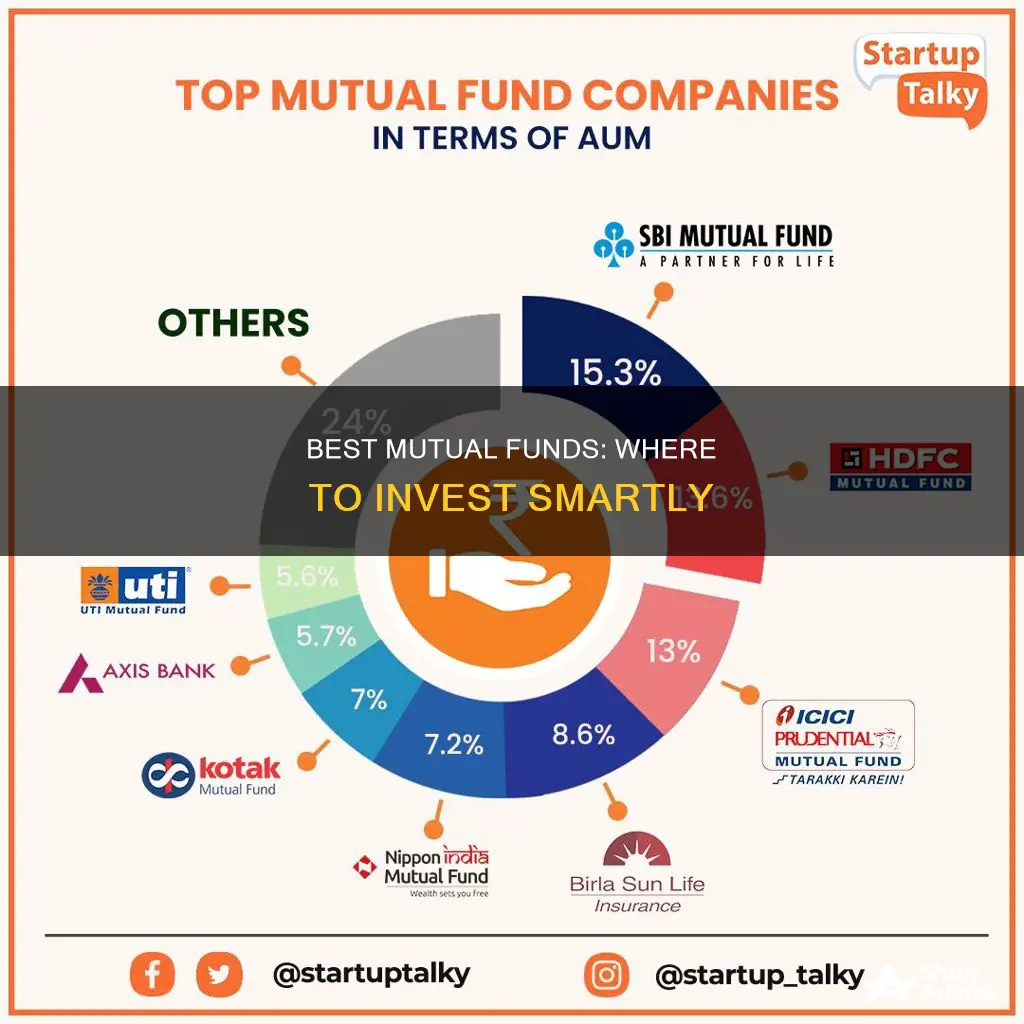
Mutual funds are a popular investment tool for both individual and professional investors. They are a good way to beat the market or access a wide range of investments without having to purchase stocks or bonds individually.
There are over 9,000 mutual funds, holding more than $16 trillion in assets. They are a good option for those who don't want to pick and choose individual investments but still want to benefit from the stock market's high average annual returns.
When choosing a mutual fund, it's important to consider factors such as fees, investment goals, and risk tolerance. It's also crucial to remember that past performance does not guarantee future results, and diversification is key to reducing risk.
| Characteristics | Values |
|---|---|
| Best-performing U.S. equity mutual funds | Fidelity Select Semiconductors, Fidelity Series Growth Company, Fidelity Growth Company Fund, Fidelity Select Technology, Fidelity Series Blue Chip Growth, Fidelity Blue Chip Growth, Columbia Seligman Tech & Info Adv |
| How to invest in mutual funds | Decide whether you want to invest in active or passive funds, calculate your investing budget, decide where to buy mutual funds, understand mutual fund fees, manage your mutual fund portfolio |
| Average mutual fund return | Stock mutual funds = higher potential returns (or losses), Bond mutual funds = lower returns (but lower risk), Money market mutual funds = lowest returns, lowest risk |
| Can you lose money in mutual funds? | Yes |
What You'll Learn

Best mutual funds for retirement planning
Retirement income funds are designed to provide a steady income stream post-retirement and ensure better capital preservation. Here are some of the best mutual funds for retirement planning:
Vanguard Target Retirement Income Fund (VTINX)
VTINX is a target-date fund for those who are already retired, with a bond-heavy strategy that prioritises income and capital preservation. The fund is split approximately 30% in stocks and 70% in bonds, including a 17% allocation to short-term Treasury Inflation-Protected Securities (TIPS). VTINX has a low expense ratio of 0.08% and requires a minimum investment of $1,000.
Fidelity Freedom Index Income Fund Investor Class (FIKFX)
Fidelity's FIKFX is a conservative, income-oriented option with no minimum investment requirements. It targets an asset allocation of around 11% in U.S. equity funds, 8% in international equity funds, and the rest in various bond funds. FIKFX has a 10-year annualised total return of 3.45% and no transaction fees on the Fidelity platform.
Schwab Monthly Income Fund Income Payout (SWLRX)
Schwab's SWLRX fund offers a variable annual yield based on market conditions, ranging from near zero to over 5%. It primarily invests in bond funds and pays monthly dividends. SWLRX has no minimum investment requirements but has a higher expense ratio.
Schwab Monthly Income Fund Flexible Payout (SWKRX)
The Schwab SWKRX fund targets a 4-6% annual yield and provides some capital appreciation. It is more aggressively allocated, with roughly half of its assets in stocks and half in bonds. SWKRX pays monthly dividends and has no minimum investment requirements, but it has a higher expense ratio.
Schwab Monthly Income Fund Target Payout (SWJRX)
Schwab's SWJRX fund aims for a fixed 5% annual yield and is designed to make greater capital gains and return of capital distributions. It is also more aggressively allocated, with a 50-50 split between stocks and bonds. SWJRX has no minimum investment requirements and pays monthly dividends, but it has a higher expense ratio.
Vanguard LifeStrategy Income Fund (VASIX)
VASIX is Vanguard's most conservative and income-focused fund, targeting short- to medium-term investment. It has a long track record, dating back to September 1994, and is globally diversified in bonds and stocks. However, it only pays quarterly dividends and has a higher minimum investment requirement of $3,000.
T. Rowe Price Dividend Growth Fund (PRDGX)
PRDGX is an actively managed fund that takes a conservative approach to dividend investing, with a Morningstar gold-star rating. It seeks out dividend stocks with strong performance and low price volatility, focusing on companies with competitive advantages, strong cash flows, and shareholder-friendly management teams.
Vanguard Wellington Fund (VWELX)
The Vanguard Wellington Fund is the oldest balanced mutual fund, launched in 1929. It typically allocates up to 70% of its portfolio to stocks and the remainder to bonds, focusing on high-quality, large-cap companies with a history of dividend growth. VWELX has a low expense ratio for an actively managed fund.
Dodge and Cox Income Fund (DODIX)
The Dodge and Cox Income Fund is an actively managed bond fund with a gold-star rating from Morningstar. It focuses on investment-grade government, agency, corporate, and municipal bonds, with over 1,300 issues and an average effective duration of 5.72 years. DODIX has outperformed its Morningstar intermediate core-plus bond fund category over the past one to 15 years.
American Funds Tax-Aware Conservative Growth and Income Portfolio (TAIFX)
TAIFX is a fund-of-funds that holds positions in six other mutual funds, with an asset mix of U.S. stocks, foreign stocks, U.S. fixed income, and cash equivalents. It aims to provide appreciation and income and has outperformed its Morningstar category average over the past one to 10 years. TAIFX has a minimum initial investment of $250.
Schwab Balanced Fund (SWOBX)
The Schwab Balanced Fund offers exposure to U.S. and international stocks, as well as U.S. fixed-income assets. It has no minimum required investment and has outperformed its Morningstar category average over the last one to 15 years. SWOBX is suitable for retirees or conservative investors seeking a balanced fund for a taxable brokerage account.
Equity Funds: Where to Invest and Why
You may want to see also

Best mutual funds for short-term goals
When investing in mutual funds, it's important to keep your investment goals in mind. If you're investing for the short term, you should focus on safety rather than returns. Here are some of the best mutual funds for short-term goals:
Short-term government bond funds
Government bonds are issued by the federal government and its agencies. Government bond funds purchase investments such as Treasury bills, Treasury bonds, Treasury notes, and mortgage-backed securities. These bonds are considered low-risk and very safe since they are backed by the full faith and credit of the government. Short-term government bond funds offer a reliable rate of interest and are highly liquid, allowing investors to buy and sell on any day the market is open.
Money market mutual funds
Money market mutual funds invest in short-term securities, including Treasurys, municipal and corporate debt, and bank debt securities. While money market funds are not as safe as FDIC-backed money market accounts, they are still considered some of the most conservative investments available. Money market mutual funds offer a yield on the invested money and are reasonably liquid, allowing investors to access their funds readily.
Short-term corporate bond funds
Corporate bonds are issued by major corporations to fund their investments. A short-term corporate bond fund provides investors with a diversified portfolio of bonds, reducing the risk associated with individual bonds. These funds are not insured by the government, so they can lose money, but bonds tend to be quite safe, especially if the fund is broadly diversified. Short-term corporate bond funds have low interest rate risk, and investors can expect regular interest payments, typically made monthly. These funds are highly liquid and can be bought and sold on any day the financial markets are open.
Short-term debt funds
Short-term debt funds, also known as short-duration funds, lend money to companies for a period of 1 to 3 years. They primarily lend to quality companies with a proven record of repaying their loans on time. Short-term debt funds aim to deliver better returns than bank fixed deposits while keeping risk under control. These funds are ideal for investors who don't need their money for at least 12 to 18 months and have an investment horizon of at least one year.
High-yield savings accounts
High-yield savings accounts at banks or credit unions offer a good alternative to checking accounts, which pay very little interest. These accounts are insured by the Federal Deposit Insurance Corporation (FDIC) or the National Credit Union Administration (NCUA), ensuring your money is safe. High-yield savings accounts typically offer higher interest rates than traditional savings accounts, and you can access your money quickly through transfers or ATMs.
When choosing a mutual fund for short-term goals, it's essential to consider factors such as safety, liquidity, and low transaction costs. Additionally, remember that short-term investments may have lower potential returns than long-term investments, so it's important to set realistic expectations.
International Index Funds: Invest Now or Miss Out?
You may want to see also

Best mutual funds for long-term goals
When investing in mutual funds, it is important to keep your investment goals in mind, as this will dictate the type of mutual fund you may want to use. For example, long-term goals that are decades in the future may be best served by stock mutual funds with more growth potential, while shorter-term goals in the next few years may require the relative stability of a bond fund.
SBI PSU Fund
SBI PSU Fund’s current net asset value (NAV) for its Growth option in the Regular plan stands at Rs. 35.57. The fund’s 1-yr return is 63.10%, and its 3-yr CAGR is 38.91%. The fund manages assets under management (AUM) worth Rs. 4851.11 cr. with an
Maximizing Your HSA: Should You Invest Your Funds?
You may want to see also

Best mutual funds for low-risk tolerance
Low-risk mutual funds are those investment options that carry minimal risk and stable returns. They are always a step ahead of inflation and invest a major chunk of their total assets in debt instruments. Here are some of the best low-risk mutual funds to consider:
Invesco India Arbitrage Fund
Invesco India Arbitrage Fund has given 7.19% annualised returns in the past three years and 6.16% in the last five years. The minimum amount required to invest in this fund via lump sum is ₹1,000 and via SIP is ₹500.
Tata Arbitrage Fund Direct Growth
Tata Arbitrage Fund has given 6.8% annualised returns in the past three years and 6.2% in the last five years. The minimum amount required to invest in this fund via lump sum is ₹5,000 and via SIP is ₹150.
Bank of India Overnight Fund Direct Growth
This fund falls under the Debt category of Bank of India Mutual Funds.
Axis Overnight Fund Direct Growth
Axis Overnight Fund has given 5.87% annualised returns in the past three years and 4.89% in the last five years. The minimum amount required to invest in this fund via lump sum is ₹5,000 and via SIP is ₹1,000.
Mirae Asset Overnight Fund Direct Growth
Mirae Asset Overnight Fund has given 5.87% annualised returns in the past three years and 4.93% in the last five years. The minimum amount required to invest in this fund via lump sum is ₹5,000 and via SIP is ₹99.
Bank of India Overnight Fund Direct Growth
This fund falls under the Debt category of BOI AXA Mutual Funds.
Quant Overnight Fund Direct Growth
Quant Overnight Fund comes under the Debt category of Quant Mutual Funds.
Kotak Equity Arbitrage Fund Direct Growth
Kotak Equity Arbitrage Fund has given 6.96% annualised returns in the past three years and 6.1% in the last five years. The minimum amount required to invest in this fund via lump sum is ₹100 and via SIP is ₹100.
Edelweiss Arbitrage Fund Direct Growth
Edelweiss Arbitrage Fund has given 6.91% annualised returns in the past three years and 6.15% in the last five years. The minimum amount required to invest in this fund via lump sum is ₹100 and via SIP is ₹100.
Nippon India Arbitrage Fund Direct Growth
Nippon India Arbitrage Fund has given 6.79% annualised returns in the past three years and 6.01% in the last five years. The minimum amount required to invest in this fund via lump sum is ₹5,000 and via SIP is ₹100.
ICICI Prudential Equity & Debt Fund
This fund falls under the HYBRID Aggressive Hybrid category and has given returns of +23.07% and +16.90% in the past.
Edelweiss Aggressive Hybrid Fund
This fund falls under the HYBRID Aggressive Hybrid category and has given returns of +20.48% and +14.45% in the past.
Baroda BNP Paribas Aggressive Hybrid Fund
This fund falls under the HYBRID Aggressive Hybrid category and has given returns of +18.44% and +15.26% in the past.
Canara Robeco Equity Hybrid Fund
This fund falls under the HYBRID Aggressive Hybrid category and has given returns of +17.43% and +14.47% in the past.
Mirae Asset Aggressive Hybrid Fund
This fund falls under the HYBRID Aggressive Hybrid category and has given returns of +16.92% and +12.92% in the past.
SBI Multi Asset Allocation Fund
This fund falls under the HYBRID Multi Asset Allocation category and has given returns of +15.11% and +12.28% in the past.
Edelweiss Balanced Advantage Fund
This fund falls under the HYBRID Dynamic Asset Allocation category and has given returns of +16.75% and +12.71% in the past.
Nippon India Balanced Advantage Fund
This fund falls under the HYBRID Dynamic Asset Allocation category and has given returns of +14.43% and +11.88% in the past.
The Ultra-Wealthy's Hedge Fund Hesitation: Why the Reluctance?
You may want to see also

Best mutual funds for high-risk tolerance
High-risk mutual funds are typically equity investments that are volatile in nature. They are best suited for investors with extensive knowledge of the market and a good understanding of macroeconomic trends. These funds are also ideal for investors with a high-risk appetite and those who do not mind exposing their portfolios to high volatility.
- Quant Multi-Asset Fund: This fund has delivered annualised returns of 22.8% over the past three years and 29.24% over the last five years. The minimum investment amount is ₹5,000 for lump-sum investment and ₹1,000 for Systematic Investment Plans (SIPs).
- HDFC Balanced Advantage Fund: With annualised returns of 21.44% in the past three years and 21.94% in the last five years, this fund has a minimum investment amount of ₹100 for both lump-sum and SIP investments.
- ICICI Prudential Bharat Consumption Fund: Offering annualised returns of 20.83% in the past three years and 20.26% in the last five years, this fund requires a minimum investment of ₹5,000 for lump-sum investment and ₹100 for SIPs.
- Nippon India Small Cap Fund: This fund has generated returns of 36.10% in the past year and 39.10% over three years.
- Edelweiss Mid Cap Fund: With returns of 31.43% in the last year and 35.03% over three years, this fund is managed by Edelweiss Asset Management Ltd.
- Nippon India Growth Fund: This fund has delivered returns of 30.55% in the last year and 34.27% over three years.
- ICICI Prudential Small Cap Fund: Offering returns of 29.92% in the past year and 31.78% over three years, this fund is managed by ICICI Prudential Asset Management Company Ltd.
- Kotak Small Cap Fund: With returns of 32.33% in the last year and 32.85% over three years, this fund has a minimum investment amount of ₹1,000 for lump-sum investment and ₹500 for SIPs.
- Invesco India Mid Cap Fund: This fund has generated returns of 28.79% in the past year and 31.83% over three years.
- Kotak Emerging Equity Fund: Offering returns of 28.83% in the last year and 31.45% over three years, this fund is managed by Kotak Mahindra Asset Management Company Limited.
True Beacon Hedge Fund: Investment Strategies and Opportunities
You may want to see also
Frequently asked questions
Some of the best mutual funds to invest in include the Vanguard Wellington Fund (VWELX), Fidelity 500 Index (FXAIX), Fidelity ZERO International Index (FZILX), and the Vanguard Total Stock Market Index Fund (VTSAX).
Mutual funds offer benefits such as diversification, affordability, professional management, and liquidity. They are also highly liquid, making them easy to buy or sell.
All investments carry some risk, but mutual funds are typically considered safer than purchasing individual stocks due to their diversification.
Yes, it is possible to lose money in mutual funds, but diversification can help spread the risk.
When choosing a mutual fund, it is important to consider your financial goals and risk tolerance. You should also research the fund's management team, turnover rate, and benefits.







